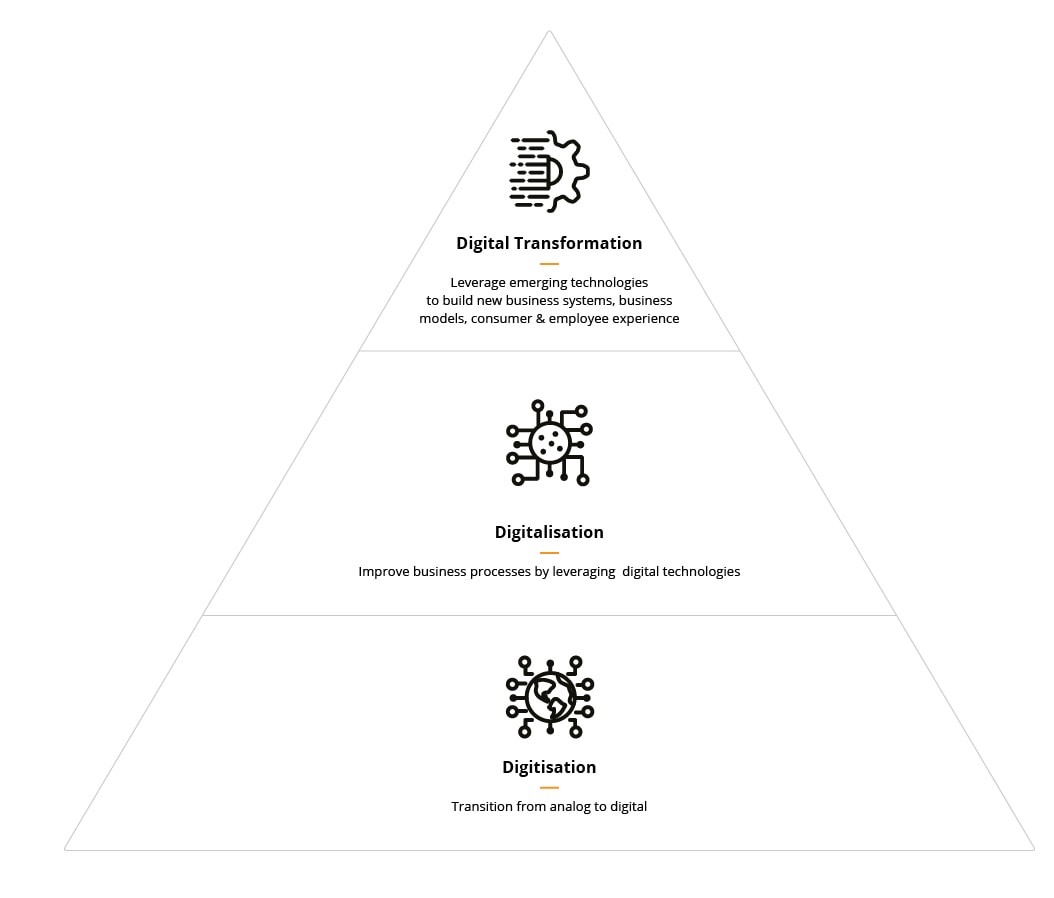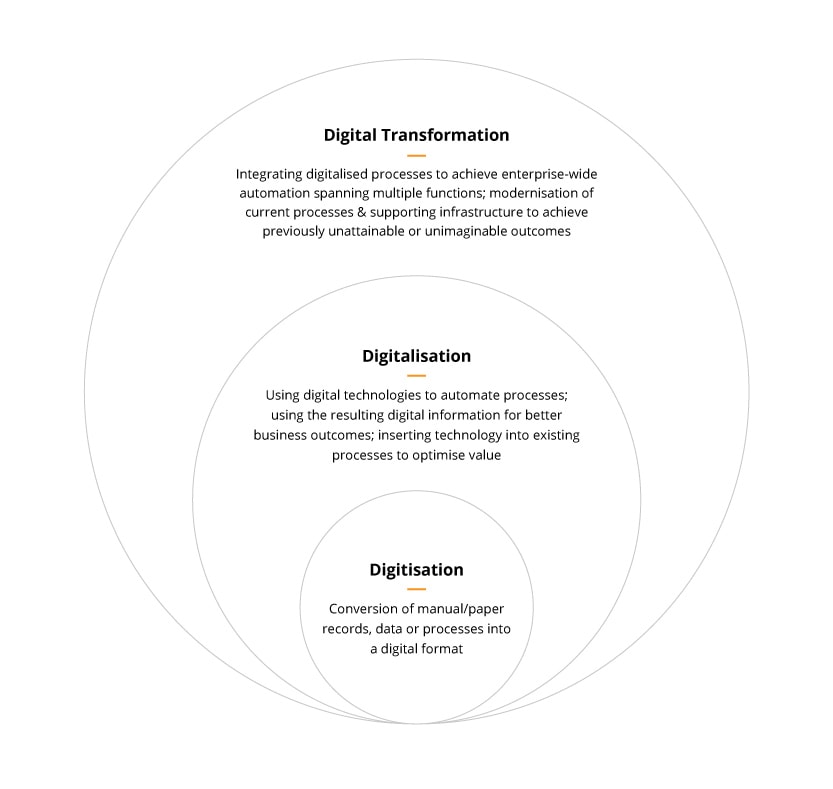
Why are digitisation, digitalisation & digital transformation crucial steps in business development?
To describe the reality we live and run business in, the modern digital era created new concepts. Three most important of them are digitisation, digitalisation and digital transformation. Let's check why they all constitute crucial steps in business development.
Digitalisation vs. digitisation vs. digital transformation strategy: understanding the differences
First, let’s understand the basics: what are the differences between these three words and why is it important to understand them as parts of a more complex business process?
Although these three definitions are closely related to each other, using them interchangeably has been a common mistake for years. When talking about digitalisation, digitisation and digital transformation, we talk about different processes that can be regarded as essential steps to take if you want to lead your business to the world of industry.
Understanding the differences between those three processes is a must-do before you get involved in any digital-related investment.
Digitisation in business: laying the foundation with digital data
DIGITISATION is the process of changing from an analogue to digital form, also known as digital enablement. Said another way, digitisation takes an analogue process and changes it to a digital form without any different-in-kind changes to the process itself.Gartner Glossary
For business, digitisation is the first step in creating significant value in digitised data ready to be analysed. Digitisation also helps save considerable amounts of meaningful documents, historical files and precious art from both destruction and oblivion. It is a fundamental component of every digital transformation, which aims to leverage technology to enhance efficiency, productivity, and competitiveness in the modern business landscape.
Examples of digitisation business operations:
handwritten documents and data sheets including customer or sales history, rewritten on the computer and converted into PDF/ Excel files,
old projects, maps or handmade instructions carefully photographed and digitised as JPG files,
analogue movies converted and compressed into H.264 or HEVC files.
Digitisation can result in several benefits for businesses, including cost reduction, improved customer service, faster decision-making and the ability to adapt to changing market conditions more rapidly. It can also facilitate the analysis and collection of data, leading to better insights and informed business strategies.
Digitalisation in business: streamlining processes with digital technology
DIGITALISATION is the use of digital technologies to change a business model and provide new revenue and value-producing opportunities.Gartner Glossary
It means we can start using digital technologies to analyse gathered data and benefit from the results. Discovering the potential of processed digital data can help us achieve different business goals, e.g.:
improve internal/external business processes,
gain higher effectiveness in various fields,
give employees access to the necessary data,
provide better understanding of the target group,
design better customer experience,
Unlike digitisation, which focuses on converting analog data into digital formats, digitalisation is a broader concept that involves reimagining and reinventing how businesses operate in the digital age. It encompasses the integration of digital technology into all aspects of a business, often as part of a larger digital transformation strategy.
Examples of digitalisation of internal processes:
uploading data from traditional Excel sheets stored on one computer to the cloud solution so that all employees involved get easy 24/7 access to the essential data,
launching new e-commerce offers with promotions targeted to individual needs (like personalised items via app),
analysing data collected by Internet-connected devices to find new revenue streams (e.g. repetitive customer request for a product that doesn’t exist in the offer yet).
Digitalisation aims to create a business environment that is more agile, customer-focused, and adaptable to changes in technology and the market. It often involves a cultural shift within the organisation to embrace digital technologies and foster a culture of data-driven innovation and continuous improvement.
Digital Transformation strategy: a holistic shift towards a digital-first culture
DIGITAL TRANSFORMATION can refer to anything from IT modernisation (for example, cloud computing), to digital optimisation, to the invention of new digital business models.Gartner Glossary
Digital transformation is the process of fully benefiting from the enormous digital potential in your business. It’s a complex change for a company that includes all aspects of business: its models, internal and external processes, management at all levels, new technologies, available digital solutions, products and services.
Examples of digital transformation:
sing automation tools in all company departments helps save time, free up internal workforces and keep all documents and crucial information in order,
transforming from a traditional CRM system to a modern cloud solution for business.

Digital transformation is a strategic initiative that requires the commitment of the entire organisation. When executed effectively, it can lead to increased efficiency, improved customer experiences, enhanced competitiveness, and the ability to seize new opportunities.
It’s important to note that successful digital transformation is not solely about technology; it’s about people, processes, and a holistic approach to modernising the organisation.
Find out more about the Digital Transformation:
Digital transformation in finance: what you have to know now
Insurance digital transformation: (r)evolution in the industry
10 benefits of a digital acceleration strategy for your business
Pros and cons of business digitalisation
The most significant benefits of digitalisation are:
optimised business processes and fewer errors,
remote access to data,
higher productivity and transparency,
increased sales with less physical documents,
reduced operational costs,
new products, digital tools and innovative processes,
competitive advantage,
cultural change,
more time for meaningful tasks.
Digitisation means converting physical materials into digital formats. When we apply technology into the existing business to improve the chosen process or create new revenue, it’s digitalisation.
Both of the above processes can exist separately, but they can be significant parts of the complex process of digital transformation. They include all aspects of business and need to be regarded as a massive change for the whole company.
After conversion, the digital-driven business operates with automated processes, integrated systems, and broad opportunities.

Examples of successful digital transformation initiatives
Successful digital transformation initiatives have been implemented across various industries.
Organisations that have recently undertaken such successful digital transformations include:
Starbucks, which implemented a digital transformation strategy that includes a mobile app for ordering and payment, loyalty programs, and digital in-store experiences,
Tesla, which regularly update vehicle software over the air, allowing for new features, performance improvements, and even autonomous driving capabilities,
Amazon, which harnessed data analytics and machine learning/artificial intelligence (AI) solutions to personalise customer experiences, optimise supply chain logistics, and automate processes like order fulfilment.
Best practices for successfully implementing digitalisation for business growth
Successfully implementing digitalisation for business growth requires a well-thought-out strategy and a commitment to change. Before you start your own journey, consider the following:
a clear strategy with goals and objectives,
customer-centric approach, which focuses on understanding and meeting the needs of your customers,
strong leadership that brings together people with different skills and expertise,
technology infrastructure with the aim of investing in the right digital tools,
cyber resilience which will protect your digital assets and sensitive data,
scalability so that you can accommodate growth of your enterprise.
Remember that a successful digitalisation requires a holistic approach that combines technology, people, processes, and a commitment to change. It’s a continuous journey that involves ongoing adaptation and evolution to remain competitive in the digital age.
Start your digital transformation project with our experts
Every step towards the digital world has its opportunities. To start the new digital era in your company, it takes courage, detailed strategy, and specialists’ support.
Suppose you are ready to make a significant change. In that case, we can lead your business through each step towards digital transformation, offering long-term partnership, constant expert support and best-fitted solutions.
Keen to talk about transforming your company into a thriving digital-driven business? Get in touch with our team of experts, ready to share their knowledge and expertise with you to help you achieve your goals!




